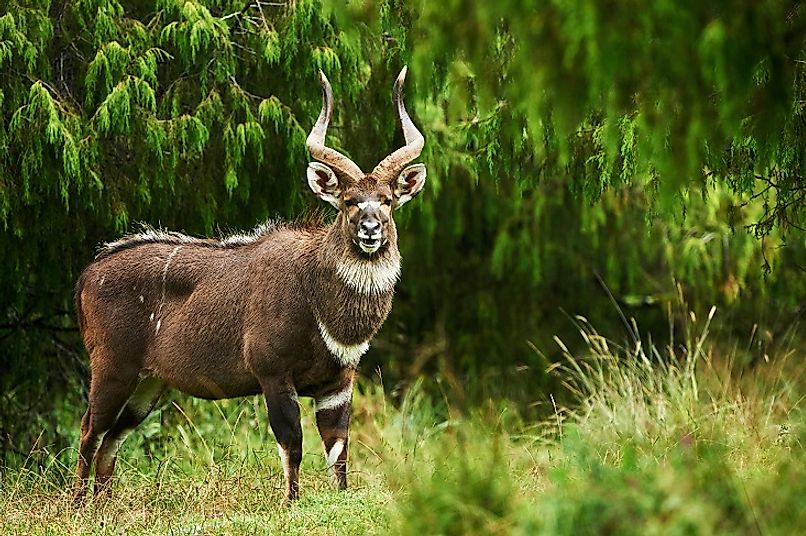Endangered Mammals Of Ethiopia

Ethiopia is a landlocked country found along the Horn of Africa. It was one of humanity's earliest settlement areas in the world, and thus filled with many archaeological sites. The country has many high places with a vast plateau covering a huge area. The country has some rivers which enable animal survival. However, the climate of the area is sunny, making it have much dry vegetation. Animals that survive in the country need to adapt to the conditions. However, the southern region enhances more luxuriant vegetation, making the area to have more animals compared to the Northern part.
Grevy’s Zebra (Equus grevyi)
The Grevy’s Zebra is 2.5 meters from head to tail, and is the largest of the three zebra species. It is occasionally referred to as the Imperial zebra. Its preferred habitat is in the semi-arid grasslands, where it can survive without water for five days at a time. The animal has no long-lasting bonds, in contrast to other types of zebras. The animal relies on grass for survival. Non-territorial males and lactating females tend to prefer areas with short grass and dense bush more than territorial males and non-lactating females. The zebra mates and reproduces year-round. However, the most preferred season for mating is between August and September after ceasing of long rains. Mating is usually promiscuous for females who have not given birth. However, those that have ever given birth tend to stay with one male for continuous reproduction.
The Grevy’s Zebra population in Ethiopia has reduced drastically over the years from 1980 to 1995. In that time, their numbers dropped from 1,900 to 577, and by 2003 they were only 106 remaining in the country. From 1980 to 2003 the population of Grevy’s Zebra had decreased by 94%. However, there has been a rise in their population from 2006 onward. The mammal has been listed by the International Union for the Conservation of Nature (IUCN) as an endangered species. The primary threats to the animal include the reduction of the water sources available to the animals, habitat degradation, and effects of overgrazing. Disease, hunting, and competition for resources also negatively affect the Grevy's zebra.
Nubian Giraffe (Giraffa camelopardalis Camelopardalis)
The Nubian Giraffe has white lines underlining its well-defined chestnut spots. On their head, you will find two knobs and extra bumps on the side of their skulls. They usually live in the woodlands and savanna. Although their running seems clumsy, they run at a speed 30 miles per hour when alarmed.
Nubian Giraffes can spend long periods without water and feed exclusively on shrubs. They are social, making them graze in groups without any apparent dominance. Their reproduction involves copulation after which the female undergoes gestation for 15 months. The animal is kept in captivity due to its endangered species.
According to the Smithsonian National Zoological Park, Nubian Giraffes are the world’s tallest living animals with their necks alone measuring 1.8 meters (6 feet) long, and their legs also measure 6 feet long. A fully grown female would weigh 680 kilograms (1,500 pounds), and the much larger males as much as 1,300 kilograms (3,000 pounds).
Mountain Nyala (Tragelaphus buxtoni)
The Mountain Nyala, similar to a type of antelope, is found in the mountainous regions of central Ethiopia. The males are typically taller than the females. Both sexes are shy towards human beings. The males do not show territorial behavior, making them graze in peace. Reproduction starts when the female reaches two years, and gestation period will last for nine months. The spiral horns are used for defense. Human settlement has led to the displacement of their habitat, and this has made them live at higher altitudes. Moreover, the desire for game meat has rendered them endangered due to the fast decline in their population.
Eastern Black Rhinoceros (Diceros bicornis michaeli)
The Eastern Black Rhinoceros is large, and weighs up to 3,000 pounds. It has a grooved skin and is the most aggressive of its species. The rhino is a browser which is common in savanna habitats and highland forests. It tends to prefer acacia scrubs and thick thorn bushes. It feeds on branches, fruits, and woody bushes. However, the animals are more nocturnal than diurnal. The males are much aggressive but tolerate submissive male intruders. The behavior discourages predators who tend to charge at young ones. It has low numbers in population due to poaching for its horn. Laws have enabled conservation of this endangered animal which had been driven almost to the brink of extinction.
Endangered Mammals Of Ethiopia
| Threatened Mammals of Ethiopia | Scientific Name |
|---|---|
| Ethiopian amphibious rat | Nilopegamys plumbeus |
| Harenna shrew | Crocidura harenna |
| Somali wild ass | Equus africanus somaliensis |
| Eastern black rhinoceros | Diceros bicornis michaeli |
| Walia ibex | Capra walie |
| Nubian giraffe | Giraffa camelopardalis camelopardalis |
| Mountain nyala | Tragelaphus buxtoni |
| Grevy's zebra | Equus grevyi |
| Ethiopian wolf | Canis simensis |
| Somali wild dog | Lycaon pictus somalicus |











